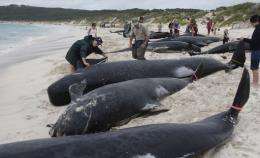Climate change to bring more whale beachings

Experts studying the mass beaching of whales along Australia's coast have warned that such tragedies could become more frequent as global warming brings the mammals' food stocks closer to shore.
Almost 90 long-finned pilot whales and bottlenose dolphins died after washing up last week at Hamelin Bay, on the country's west coast.
It was the second mass stranding in March, and took the total number of cetaceans to beach in southern Australia in the past four months beyond 500, including a single stranding of almost 200 on King Island.
Researchers tracking the beaching of whales in the region since 1920 said strandings tended to occur in 12-year cycles which coincided with cooler, nutrient-rich ocean currents moving from the south and swelling fish stocks.
"These animals, most of the time they're trying to find food, that's what they do," said the project's Corey Bradshaw, from Adelaide University.
"If you bring them closer to an area that could be dangerous, simply because there's more food there than there normally is you'd expect to find these temporal peaks in strandings, and that's exactly what we've found," Bradshaw told AFP.
The current cycle last peaked in the 2004/2005 southern hemisphere summer, said Bradshaw, when there were 30 strandings in a period of weeks and a new animal washed up every four days.
The total number of stranding events that summer was almost equivalent to those recorded for the entire previous year, he said, adding that the numbers again appeared to be reaching a peak.
"With climate change it is more likely that these kinds of oscillations will be more variable so you get more extreme conditions," he said.
"Where you maybe get a really cold pulse once every ten years it might happen every five years, and we're already seeing that."
"We could see more and more frequent strandings simply as a function of higher frequency (of) extreme events," he added.
Little concrete was known about what caused whales to beach en masse, according to marine scientist Catherine Kemper, who said the theories were almost endless.
Only highly social species beached in groups, she said, and if one creature got into trouble or fled a predator such as a killer whale the rest would follow.
Geomagnetic interference from elements such as iron ore could also scramble a cetacean's sonar, and complex coastlines such as that of Tasmania could be difficult to navigate, said Kemper, of the South Australian museum.
"Toothed whales have echo location, and one of the theories is that something happens to their ability to navigate," she said.
The island of Tasmania, Australia's southernmost state, also had a narrow continental shelf, meaning there was deep water close to the coast.
"If a few of them come onshore the rest follow because of this incredible social bond," said Kemper.
Storm events could also impair navigation by stirring up sediment, said government scientist Nick Gales, who works for the Antarctic authority.
"This becomes incredibly confusing for animals that use sound in the water column to navigate in the shallower waters," he said.
"There is no real way of predicting these (incidents).
"The main advances in science have been in trying to deal with those animals once they are ashore, understanding a lot more about the animals from access to them and most recently in actually tracking animals that are able to be refloated and pushed out to sea."
Of the pod which came ashore at Hamelin Bay, 11 were released back into the ocean using cranes fitted with giant slings.
Once lifted to a truck, the 3.5-tonne mammals were transported 15 kilometres (nine miles) to a more sheltered harbour for release.
It was only the third time such an ambitious rescue of whales had been attempted in Western Australia state, and the first involving the long-finned pilot species.
Only three managed to return to deeper waters, with the remaining seven either euthanised or dying after re-beaching themselves, including a female and her calf.
Kemper said the success of rescue operations often depended on the fate of the "ringleaders".
"Either they die and (rescuers) get them out of the way, or they get them alive and back out to sea," she said.
"The chances of success for rescuing at least some are greater because, again, I guess it's like follow the leader."
Ultimately though, Bradshaw said mass beachings remained one of nature's great mysteries.
"There are reams of hypotheses, predilections and pet theories, most of them have absolutely no basis whatsoever," he said.
"Let's face it, this is biological life, we're all prone to making mistakes."
(c) 2009 AFP















